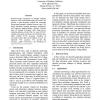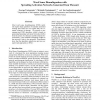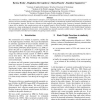IJIS
2008
13 years 11 months ago
2008
The ability to analyse and represent formally semantic relations of terms is a core issue in information retrieval (IR), natural language processing (NLP), and in many related are...
TREC
2000
14 years 26 days ago
2000
CL Research's question-answering system (DIMAP-QA) for TREC-9 significantly extends its semantic relation triple (logical form) technology in which documents are fully parsed...
ACL
2003
14 years 28 days ago
2003
This paper proposes a principled approach for analysis of semantic relations between constituents in compound nouns based on lexical semantic structure. One of the difficulties o...
EACL
2006
ACL Anthology
14 years 28 days ago
2006
ACL Anthology
GOD (General Ontology Discovery) is an unsupervised system to extract semantic relations among domain specific entities and concepts from texts. Operationally, it acts as a search...
EMNLP
2004
14 years 28 days ago
2004
Broad-coverage repositories of semantic relations between verbs could benefit many NLP tasks. We present a semi-automatic method for extracting fine-grained semantic relations bet...
ACL
2006
14 years 28 days ago
2006
We propose a novel method for automatically interpreting compound nouns based on a predefined set of semantic relations. First we map verb tokens in sentential contexts to a fixed...
ACL
2004
14 years 28 days ago
2004
A crucial step toward the goal of automatic extraction of propositional information from natural language text is the identification of semantic relations between constituents in ...
IJCAI
2007
14 years 29 days ago
2007
Most word sense disambiguation (WSD) methods require large quantities of manually annotated training data and/or do not exploit fully the semantic relations of thesauri. We propos...
LREC
2008
14 years 29 days ago
2008
The construction of a wordnet, a labour-intensive enterprise, can be significantly assisted by automatic grouping of lexical material and discovery of lexical semantic relations. ...
LREC
2008
14 years 29 days ago
2008
This paper presents a supervised method for the detection and extraction of Causal Relations from open domain text. First we give a brief outline of the definition of causation an...



